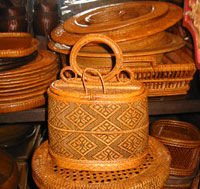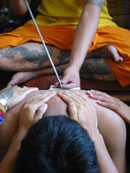Baskets
Need to carry some dirt? Catch a fish? Transport bundles of food or clothing? Store some household items? Fetch some water? Gather leaves after raking? Bring some lunch with you to work? Transport a pig to the market? You don’t need a shovel, fishing pole, suitcase, trunk, bucket, lunchbox, plastic bag, or cage. All you need is a basket.
Baskets come in every shape and size in Thailand; in the course of a day you might end up buying your lunch from baskets being carried on the ends of poles by a street vendor. These baskets are called ‘gradjad mon’ in Thai while the whole carrying device is called ‘harp’. Or you might wind up watching someone empty their fish trap (called ‘sum pla’ in Thai) in the shallow areas of a flooded rice field.
Baskets have existed in Thailand since the Neolithic era. Evidence of their long and enduring presence can be witnessed today in cave paintings, through archaeological finds, in mural paintings, and on most street corners. Unlike in the West, where baskets usually sit passively as decorative items and are occasionally used for picnics and as dirty clothes receptors, baskets made from natural materials in Thailand are used in a host of daily chores despite the invasion of plastic.
in the West, where baskets usually sit passively as decorative items and are occasionally used for picnics and as dirty clothes receptors, baskets made from natural materials in Thailand are used in a host of daily chores despite the invasion of plastic.
Cylindrical baskets were a natural evolvement from early weaving methods when natural materials were woven into flat sheets and used as house walls, floors and sleeping mats. Bamboo is by far the most commonly found material used in basketry and weaving, but grasses, ferns, rattan, palms, wood and reeds are all incorporated into sometimes simple and sometimes spectacular patterns and forms which are typically geometric in shape. Once almost entirely utilitarian in nature, modern times have given birth to baskets in the form of jewelry boxes, pocketbooks, and lampshades, to name a few.
Given the importance of baskets, one can imagine the vast amount of styles and functions they serve throughout the country. Common utilitarian baskets in Thailand illustrate that necessity is indeed the mother of invention. They include rice baskets (used not only to transport rice but to measure it), seed containers (lacquered baskets that keep contents safe from water and insects) water baskets (made out of palm leaves and typically fitted with a handle), glutinous rice baskets (used to store ‘sticky rice’ and often carried as lunch pails, especially in northeastern Thailand), and perhaps the most famous of Thai baskets, the fish trap: a bomb-shaped, three-foot long basket that allows fish to swim in, but not out.
Common utilitarian baskets in Thailand illustrate that necessity is indeed the mother of invention. They include rice baskets (used not only to transport rice but to measure it), seed containers (lacquered baskets that keep contents safe from water and insects) water baskets (made out of palm leaves and typically fitted with a handle), glutinous rice baskets (used to store ‘sticky rice’ and often carried as lunch pails, especially in northeastern Thailand), and perhaps the most famous of Thai baskets, the fish trap: a bomb-shaped, three-foot long basket that allows fish to swim in, but not out.
Thailand has diverse climates. Therefore each region has its own distinctive and celebrated style of basketry. This is often determined by the raw materials available in that area and, of course, the function the basket is supposed to serve. Before visiting a specific area of Thailand, a bit of research will let you find out what kind of basketry the area is famous for. Basketry is also heavily promoted by the tourist industry in Thailand. There is a host of tour operators that will be more than happy to take you to local production shops and vending area.
also heavily promoted by the tourist industry in Thailand. There is a host of tour operators that will be more than happy to take you to local production shops and vending area.
Like most crafts in Thailand, basket weaving was a skill that was passed down from generation to generation. However, due to modern times, a taste for things from the West, and availability of cheap plastic goods, traditional knowledge of the craft has begun to fade. However, it is still possible to wander around small villages and see basket weaving in progress. Thanks to the efforts of Her Majesty Queen Sirikit, many rural villagers continue to earn supplemental income through their weaving skills when they are not out in the rice fields.
Through her programme, ‘Foundation for the Promotion of Supplementary Occupations and Related Techniques, popularly known as SUPPORT, a revival of traditional skills has taken place and basketry as a means of increasing rural income has become a reality. In fact, baskets are enjoying somewhat of a renaissance and are no longer viewed as something used by ‘the common folk.’ Sophisticated basket artistry can be found at the chicest of shops, while their rustic counterparts stand as firmly as ever at local markets. Baskets, they’ve been around forever and they are here to stay. Plastic bags and boxes simply can’t hold a candle to them.
Spending time watching for different baskets pass you by is yet another fun way to pass the time in Thailand. Guessing what their probable function is can be a challenge. I once saw a wall filled with long and narrow baskets from a distance and thought they were car mufflers. And will never forget the day I decided I wanted to cook glutinous rice for dinner. Explaining my plan to a neighbour and my need to borrow the necessary tools, I was handed a wide mouthed funnel shaped basket and a big pot with a smile. Naturally, the next few minutes consisted of mass confusion of my part.
